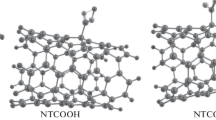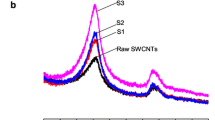Abstract
The interaction between drugs and single-walled carbon nanotubes is proving to be of fundamental interest for drug system of delivery and nano-bio-sensing. In this study, the interaction of pristine CNT with carbazochrome, an anti-hemorrhagic or hemostatic agent, was investigated with M06-2X functional and 6-31G* basis set. All probable positions of related adsorption for these kind drugs were thought-out to find out which one is energetically suitable. Based on the achieved data, the stronger interactions appeared the oxygen atom of C = O group and nitrogen atom of imine groups. The topology analysis of QTAIM (quantum theory of atoms in a molecule) method was accomplished to understand the properties of interactions between the CNT and carbazochrome. Frontier molecular orbital energies of all systems, global index including stiffness, softness, chemical Gibbs energies, and electrophilicity parameters, as well as some other important physical data such as dipole moment, polarizability, anisotropy polarisibility, and hyperpolaribility were calculated, evaluated, and then compared together. The essence of the formed bonding model progress along the reaction roots was further validated using electron localization function (ELF) calculations. The highest values of adsorption energies were determined in the range of 18.24 up to 22.12 kcal mol−1 for these kind systems. The acceptable recovery time of 849 s was obtained for the desorption of carbazochrome from the CNT surface under UV-light. The final results exhibit that carbazochrome can serve as a promising carrier and also as sensitive sensors in any kind of practical application.





Similar content being viewed by others
Data availability
All data generated or analyzed during this study are included in this published article.
Code availability
N/A.
References
Verstraete M (1977) Haemostatıc drugs: a critical appraisal
Dykes ER, Anderson R (1961) Carbazochrome salicylate as a systemic hemostatic agent in plastic operations: a clinical evaluation. JAMA 177(10):716–717. https://doi.org/10.1001/jama.1961.73040360021012e
Meenashi R, Jayalakshmi P, Jothi B, Selvaraju K, Stephen AD (2019) Ab initio prediction of stable crystal structure of procarbazine molecule. IJRAR 6(2):25–34. https://doi.org/10.26713/JAMCNP.V6I1.1114
Ibrahim KS (2013) Carbon nanotubes–properties and applications: a review. Carbon Lett 14(3):131–144. https://doi.org/10.5714/CL.2013.14.3.131
Devarajan PV, Jain S (eds) (2014) Targeted drug delivery: concepts and design advances in delivery science and technology. Springer, Cham, Heidelberg, New York
Heister E, Brunner EW, Dieckmann GR, Jurewicz I, Dalton AB (2013) Are carbon nanotubes a natural solution? Applications in biology and medicine. ACS Appl Mater Interfaces 5:1870–1891. https://doi.org/10.1021/am302902d
Berber S, Kwon YK, Tom´anek D (2000) Unusually high thermal conductivity of carbon nanotubes. Phys Rev Lett 84:4613–4616. https://doi.org/10.1103/PhysRevLett.84.4613
White CT, Todorov TN (1998) Carbon nanotubes as long ballistic conductors. Nature 393:240–241. https://doi.org/10.1038/3042
Shi Kam NW, Jessop TC, Wender PA, Dai H (2004) Nanotube molecular transporters: internalization of carbon nanotube-protein conjugates into mammalian cells. J Am Chem Soc 126(22):6850–6851. https://doi.org/10.1021/ja0486059
Taft BJ, Lazareck AD, Withey GD, Yin A, Xu JM, Kelley SO (2004) Site-specific assembly of DNA and appended cargo on arrayed carbon nanotubes. J Am Chem Soc 126(40):12750–12751. https://doi.org/10.1021/ja045543d
Zare K, Shadmani N (2013) Comparison of drug delivery systems: nanotube and p-sulphonatocalix[4]arene, by density functional theory. J Nanostructure Chem 3(72):1–6 (http://www.jnanochem.com/content/3/1/72)
Hirsch A, Lamparth I, Groesser T, Karfunkel HR (1994) Regiochemistry of multiple additions to the fullerene core: synthesis of a th-symmetric hexakis adduct of ith bis(ethoxycarbonyl)methylene. J Am Chem Soc 116:9385–9386. https://doi.org/10.1021/ja00099a088
Karimzadeh S, Safaei B, Jen TC (2021) Theorical investigation of adsorption mechanism of doxorubicin anticancer drug on the pristine and functionalized single-walled carbon nanotube surface as a drug delivery vehicle: A DFT study. J Mol Liq 322:114890. https://doi.org/10.1016/j.molliq.2020.114890
Olanow CW, Stern MB, Sethi K (2009) The scientific and clinical basis for the treatment of Parkinson disease. Neurology 72(21 Suppl 4):S1-136. https://doi.org/10.1212/WNL.0b013e3181a1d44c
Vashist SK, Zheng D, Pastorin G, Al-Rubeaan K, Luong JH, Sheu FS (2011) Delivery of drugs and biomolecules using carbon nanotubes. Carbon 49(13):4077–4097. https://doi.org/10.1016/j.carbon.2011.05.049
Wright LR, Rothbard JB, Wender PA (2003) Guanidinium rich peptide transporters and drug delivery. Curr Proteomics 4:105–124. https://doi.org/10.2174/1389203033487252
Langel U (2006) Cell-penetrating peptides: processes and applications, 2nd edn. CRC Press, Boca Raton
Berber S, Kwon YK, Tománek D (2000) Unusually high thermal conductivity of carbon nanotubes. Phys Rev Lett 84:4613–4616 (https://link.aps.org/doi/10.1103/PhysRevLett.84.461)
Shi Kam NW, Jessop TC, Wender PA, Dai H (2004) Nanotube molecular transporters: internalization of carbon nanotube-protein conjugates into Mammalian cells. J Am Chem Soc 126(22):6850–6851. https://doi.org/10.1021/ja0486059
Xu H, Li L, Fan G, Chu X (2018) DFT study of nanotubes as the drug delivery vehicles of Efavirenz. Comput Theor Chem 1131:57–68. https://doi.org/10.1016/j.comptc.2018.03.032
El Khalifi M, Duverger E, Boulahdour H, Picaud F (2015) Theoretical study of the interaction between carbon nanotubes and carboplatin anticancer molecules. Anal Methods 7:10145–10150. https://doi.org/10.1016/j.molliq.2019.04.016
Yoosefian M, Jahani MA (2019) Molecular study on drug delivery system based on carbon nanotube for the novel norepinephrine prodrug. Droxidopa J Mol Liq 284:258–264. https://doi.org/10.1016/j.molliq.2019.04.016
Frisch MJ, Trucks GW, Schlegel HB, Scuseria GE, Robb MA, Cheeseman JR, Scalmani G, Barone V, Mennucci B, Petersson GA, Nakatsuji H, Caricato M, Li X, Hratchian HP, Izmaylov AF, Bloino J, Zheng G, Sonnenberg JL, Hada M, Ehara M, Toyota K, Fukuda R, Hasegawa J, Ishida M, Nakajima T, Honda Y, Kitao O, Nakai H, Vreven T, Montgomery JA, Jr Peralta E, Ogliaro F, Bearpark M, Heyd JJ, Brothers E, Kudin KN, Staroverov VN, Kobayashi R, Normand J, Raghavachari K, Rendell A, Burant JC, Iyengar SS, Tomasi J, Cossi M, Rega N, Millam JM, Klene M, Knox JE, Cross B, Bakken V, Adamo C, Jaramillo J, Gomperts R, Stratmann RE, Yazyev O, Austin AJ, Cammi R, Pomelli C, Ochterski JW, Martin RL, Morokuma K, Zakrzewski VG, Voth GA, Salvador P, Dannenberg JJ, Dapprich S, Daniels AD, Farkas O, Foresman JB, Ortiz JV, Cioslowski J, Fox D J (2009) Gaussian Inc. Gaussian, Inc., Gaussian 09, Revision D.01, Wallingford CT, (2013)
Boys F, Bemardi F (1970) The calculation of small molecular interactions by the differences of separate total energies. Some procedures with reduced errors. Mol Phys 19:553–566. https://doi.org/10.1080/00268977000101561
Lu T, Chen F (2012) Multiwfn: a multifunctional wavefunction analyser. J Comput Chem 33:580–592. https://doi.org/10.1002/jcc.22885
Bader RFW (1985) Atoms in molecules. Acc Chem Res 18:9–15. https://doi.org/10.1021/ar00109a003
Sheikhi M, Ahmadi Y, Kaviani S (2021) Shahab S (2021) Molecular modeling investigation of adsorption of Zolinza drug on surfaces of the B12N12 and Al12N12 nanocages. Struct Chem 32:1181–1196. https://doi.org/10.1007/s11224-020-01697-4
Shahab S, Sheikhi M, Filippovich L, Anatol’evich DE, Yahyaei H (2017) Quantum chemical modeling of new derivatives of (E, E)-azomethines: Synthesis, spectroscopic (FT-IR, UV/Vis, polarization) and thermophysical investigations. J Mol Struct 1137:335–348. https://doi.org/10.1016/j.molstruc.2017.02.056
Bader RFW, Streitwieser A, Neuhaus A, Laidig KE, Speers P (1996) Electron delocalization and the Fermi hole. J Am Chem Soc 118:4959–4965. https://doi.org/10.1021/ja953563x
Bader RFW (1990) Atoms in molecule: a quantum theory. Oxford Univ press, Oxford
Becke AD, Edgecombe KE (1990) A simple measure of electron localization in atomic and molecular systems. J Chem Phys 92:5397. https://doi.org/10.1063/1.458517
Lu T, Chen F (2012) Quantitative analysis of molecular surface based on improved marching tetrahedra algorithm. J Mol Graph Model 38:314–323. https://doi.org/10.1016/j.jmgm.2012.07.004
Savin A, Flad HJ, Flad J, Preuss H, von Schnering HJ (1992) On the bonding in carbosilanes. Angew Chem Int EdEngl 31(2):185–187. https://doi.org/10.1002/anie.199201851
Becke AD (2000) Chemical content of the kinetic energy density. J Mol Struct (THEOCHEM) 527:51–56
Khalili Z, DarvishGanji M, Mehdizadeh M (2018) Fluorouracil functionalized Pt-doped carbon nanotube as drug delivery nanocarrier for anticarcinogenic drug a B3LYP-D3 study. J Nanoanalysis 5(3):202–209. https://doi.org/10.22034/jna.2018.543692
Shahabi M, Raissi H (2017) Screening of the structural, topological, and electronic properties of the functionalized graphene nanosheets as potential Tegafur anticancer drug carriers using DFT method. J Biomol Struct Dyn 36(10):2517–2529. https://doi.org/10.1080/07391102.2017.1360209
Dastani N, Arab A, Raissi H (2020) Adsorption of Ampyra anticancer drug on the graphene and functionalized graphene as template materials with high efficient carrier. Adsorption 26:879–893. https://doi.org/10.1007/s10450-019-00142-1
Steiner E, Fowler PW (2001) Patterns of ring currents in conjugated molecules: a few-electron model based on orbital contributions. J Phys Chem A 105(41):9553–9562. https://doi.org/10.1021/jp011955m
Steiner E, Fowler PW, Havenith RWA (2002) Current densities of localized and delocalized electrons in molecules. J Phys Chem A 106(30):7048–7056. https://doi.org/10.1021/jp020819u
Frost A, Musulin B (1953) A mnemonic device for molecular orbital energies. J Cheme Physic 21:572. https://doi.org/10.1063/1.1698970
JalaliSarvestani M, Ahmadi R (2017) Investigating the complexation of a recently synthesized phenothiazine with different metals by density functional theory. Int J New Chem 4(4):101–110. https://doi.org/10.22034/IJNC.2017.30984
JalaliSarvestani M, Majedi S (2020) A DFT study on the interaction of alprazolam with fullerene (C20). J Chem Lett 1(1):32–38. https://doi.org/10.22034/JCHEMLETT.2020.108111
Hamzehloueian MA (2017) Density functional theory study on the reaction mechanism of hydrazones with a-oxo-ketenes: comparison between stepwise 1,3-dipolar cycloaddition and DielseAlder pathways. C R Chim 20(5):508–519. https://doi.org/10.1016/j.crci.2016.09.002
Safdari F, Raissi H, Shahabi M, Zaboli M (2017) DFT calculations and molecular dynamics simulation study on the adsorption of 5-fuorouracil anticancer drug on graphene oxide nanosheet as a drug delivery vehicle. J Inorg Organomet Polym Mater 27:805–817. https://doi.org/10.1007/s10904-017-0525-9
Kanis DR, Ratner MA, Marks TJ (1994) Design and construction of molecular assemblies with large second-order optical nonlinearities quantum chemical aspects. Chem Rev 94(1):195–224. https://doi.org/10.1021/cr00025a007
Thanthiriwatte KS, De Silva KMN (2002) Non-linear optical properties of novel fluorenyl derivatives-ab initio quantum chemical calculations. J Mol Struct THEOCHEM 617:169–175. https://doi.org/10.1016/S0166-1280(02)00419-0
Kleinman DA (1962) Nonlinear dielectric polarization in optical media. Phys Rev 126(6):1977–1979. https://doi.org/10.1103/PhysRev.126.1977
Shokuhi Rad A, Aghaeib SM, Aalia E, Peyravic M (2017) Study on the electronic structure of Cr- and Ni-doped fullerenes upon adsorption of adenine a comprehensive DFT calculation. Diam Relat Mater 77:116–121. https://doi.org/10.1016/j.saa.2020.119082
Arulmozhi S, Madhavan J (2015) Molecular structure, first-order hyperpolarizability and HOMO-LUMO studies of L-histidinium dinitrate. Int Conf Mater Sci Technol 73:012035. https://doi.org/10.1088/1757-899X/73/1/012035
Yang Y, Ostadhosseini NA (2021) Theoretical investigation on the mercaptopurine drug interaction with boron nitride nanocage solvent and density functional effect Phys E Low-dimens. Syst Nanostruct 125:114337. https://doi.org/10.1016/j.physe.2020.114337
Funding
This study received financial support from Kastamonu University.
Author information
Authors and Affiliations
Contributions
The first draft of the manuscript was written by Fatma Kandemirli and Hakan S. Sayiner, and all authors commented on previous versions of the manuscript. All authors contributed to the study conception and design, material preparation, data collection, research design, the acquisition, analysis, and interpretation of data. All authors read and approved the final manuscript.
Corresponding author
Ethics declarations
Conflict of interest
The authors declare no competing interests.
Additional information
Publisher's note
Springer Nature remains neutral with regard to jurisdictional claims in published maps and institutional affiliations.
Rights and permissions
About this article
Cite this article
Sayiner, H.S., Kandemirli, F., Dalgic, S.S. et al. Carbazochrome carbon nanotube as drug delivery nanocarrier for anti-bleeding drug: quantum chemical study. J Mol Model 28, 11 (2022). https://doi.org/10.1007/s00894-021-04948-1
Received:
Accepted:
Published:
DOI: https://doi.org/10.1007/s00894-021-04948-1




